
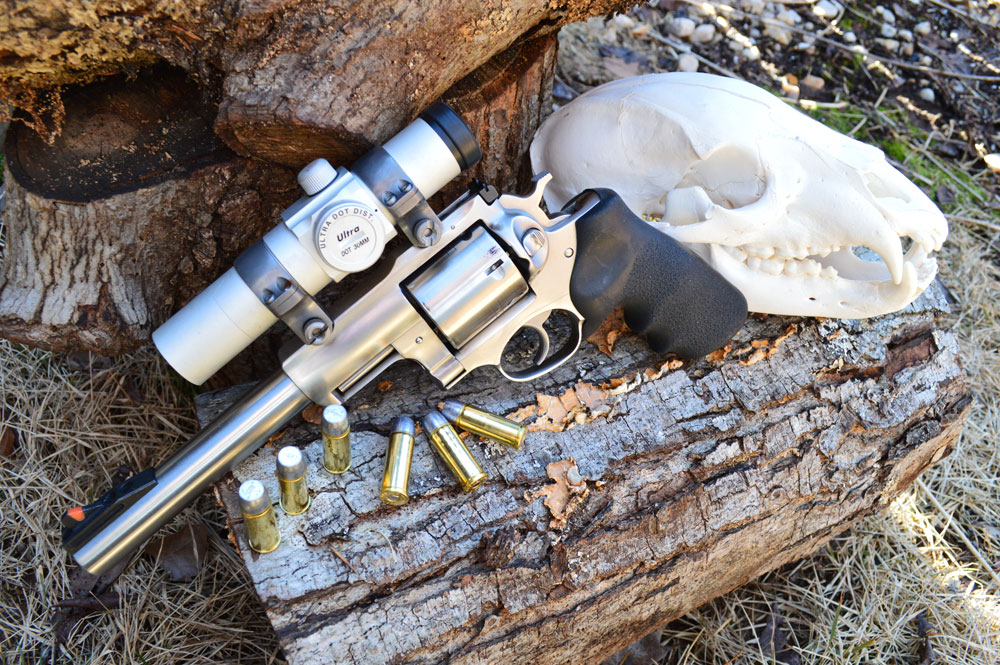 There are three notable cartridges in the .475-inch diameter category — the .480 Ruger, .475 Linebaugh and the .475 Maximum or Linebaugh Long. The progenitor of all three of these cartridges is the .475 Linebaugh, which spawned both the shorter .480 Ruger and the longer .475 Maximum. John Linebaugh is responsible for bringing his namesake .475 into this world by cutting the .45-70 Government down to 1.4 inches and necking the case to .476 inches. This caliber category is serious big-game medicine and represents a significant step up in terminal effectiveness from the various .45-calibers.
There are three notable cartridges in the .475-inch diameter category — the .480 Ruger, .475 Linebaugh and the .475 Maximum or Linebaugh Long. The progenitor of all three of these cartridges is the .475 Linebaugh, which spawned both the shorter .480 Ruger and the longer .475 Maximum. John Linebaugh is responsible for bringing his namesake .475 into this world by cutting the .45-70 Government down to 1.4 inches and necking the case to .476 inches. This caliber category is serious big-game medicine and represents a significant step up in terminal effectiveness from the various .45-calibers.
.480 Ruger
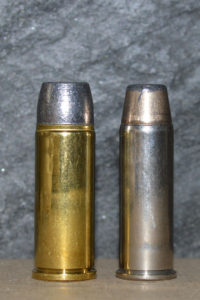 The .480 Ruger is, essentially, a shortened .475 Linebaugh. The first loads offered to the public did not show the true potential of the cartridge, featuring relatively light-for-caliber bullets at moderate velocities. It was also overshadowed by the aggressive marketing of the .500 S&W Magnum and later the .460 S&W Magnum. To that end, it never really stood a chance, as it could not boast being the biggest or the fastest. What Sturm, Ruger & Company did create, though, is a relatively mild recoiling and effective round that, in my opinion, is one of the better all-around choices for the big-game handgun hunter.
The .480 Ruger is, essentially, a shortened .475 Linebaugh. The first loads offered to the public did not show the true potential of the cartridge, featuring relatively light-for-caliber bullets at moderate velocities. It was also overshadowed by the aggressive marketing of the .500 S&W Magnum and later the .460 S&W Magnum. To that end, it never really stood a chance, as it could not boast being the biggest or the fastest. What Sturm, Ruger & Company did create, though, is a relatively mild recoiling and effective round that, in my opinion, is one of the better all-around choices for the big-game handgun hunter.
Released in conjunction with the Super Redhawk chambered in this caliber, the revolver was a good platform from which to debut the new round bearing the Ruger name on its head stamp. Recoil, while expectedly stout, still pales next to the .454 Casull loaded to spec, even though the .480 boasts a larger diameter. The .480 can be loaded close to the levels of the .475 Linebaugh but cannot achieve the higher velocities. Don’t let that fool you into thinking the .480 Ruger isn’t a serious cartridge. There is no game animal walking this planet that the .480 Ruger cannot comfortably take when loaded appropriately for the task at hand. Loaded to SAAMI specification pressure of just under 48,000 psi, only 2,000 psi separates the .480 Ruger from the .475 Linebaugh.
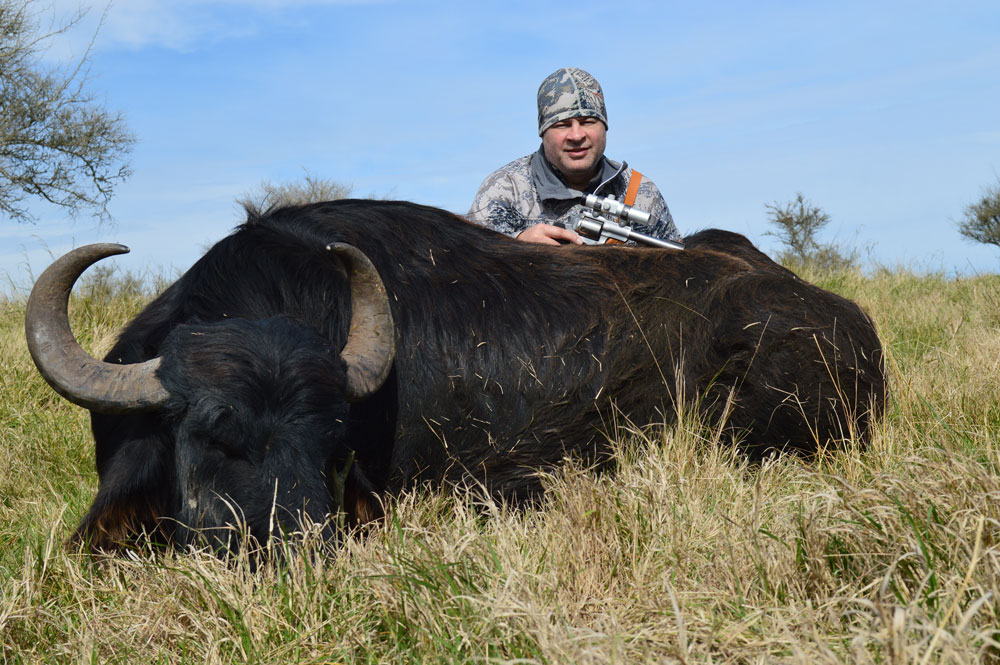
I like this round. Even when loaded with heavy bullets — 400 grains and beyond — the impulse is mild and creates more of a push than a sharp jab. Start pushing similarly weighted bullets up over 1,300 fps, though, and this is where the party starts. Plus, all factory revolver offerings in .480 Ruger are of sufficient bulk to tame even the hottest .480 loads. As a milder version of the .475 Linebaugh, what’s not to like? This is a great choice if you want big-bore knockdown power without debilitating recoil, all in a very controllable package.
I have a long relationship and history with the .480 Ruger that began in 2001 with the release of the new cartridge in the Ruger Super Redhawk. I was intrigued with the new chambering in the big, gray revolver and had to have it when I first laid eyes on it. With factory loads, that revolver proved very accurate. I took a number of Florida wild hogs with it and, thinking I needed more horsepower, eventually had it fitted with a five-shot cylinder in .475 Linebaugh. In that configuration I took a lot of big game. I tested a couple more .480 Super Redhawks over the years and was among the first to test the new Super Blackhawk in .480 Ruger, putting nearly 5,000 rounds downrange in testing. Long live the .480 Ruger!
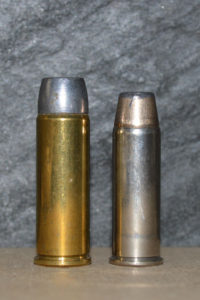 .475 Linebaugh
.475 Linebaugh
A personal favorite of mine, the .475 Linebaugh was unleashed on an unsuspecting handgun world in 1988 by John Linebaugh. The original parent case of the then-wildcat was the .45-70 Government cut down to 1.4 inches with a .476-caliber bullet. This cartridge is truly serious and has taken the largest and most dangerous game that Africa and the rest of the world has to offer, cementing its position in the realm of big-game hunting cartridges.
In its first iteration, it pushed a 400- to 420-grain bullet to speeds up to 1,400 fps. The recoil is stout by anyone’s standards. This is not a cartridge for the uninitiated, as it kicks on both ends.
Ross Seyfried first wrote about the .475 Linebaugh in the pages of the May 1988 issue of Guns & Ammo magazine. The article was appropriately dubbed, “.475 Monster Magnum … The ‘Outer-Limit’ Handgun.” If that article hadn’t gotten your blood pumping, he followed it up with an essay called “.475 Revolver Down Under” in the December 1989 issue of the same publication. In this article, Seyfried succinctly stated, “The .475 revolver cartridge was designed to be the ultimate big-game round for use in handguns. It represents a monumental step up from the .44s and a considerable increase in horsepower over any of the .45-caliber cartridges. This combination of long, heavy bullets and moderately high velocity makes even the highly touted .454 Casull seem small and ineffective.”

Seyfried then proceeded to knock down all kinds of big game in Australia with a John Linebaugh-built Ruger Bisley .475, including feral goats, pigs, donkeys, wild cattle and even an Indian water buffalo. Seyfried’s first shot on the water buffalo resulted in two broken front shoulders. The effectiveness of the cartridge on big game cannot be argued. The .475 Linebaugh represents a standard by which all big-game revolver hunting cartridges are measured.
Brass is readily available for handloading from two sources, Hornady and Starline. Loaded ammunition is available from a number of sources, including Hornady, Buffalo Bore and Grizzly Cartridge Company.
.475 Maximum or Linebaugh Long
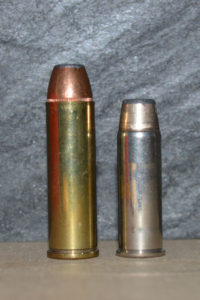 The January 1991 issue of Guns & Ammo magazine introduced big-bore handgun nuts to the .475 Maximum, and its bigger brother, the .500 Maximum. Ross Seyfried was once again responsible for the exposure, having thoroughly tested the cartridge in a John Linebaugh-built revolver. Also known as the .475 Linebaugh Long, this round is merely a .475 Linebaugh lengthened 0.2 inches to 1.6 inches. The extra length ensured the new round was able to achieve velocities somewhere around 150 fps more than its shorter counterpart while maintaining similar pressures.
The January 1991 issue of Guns & Ammo magazine introduced big-bore handgun nuts to the .475 Maximum, and its bigger brother, the .500 Maximum. Ross Seyfried was once again responsible for the exposure, having thoroughly tested the cartridge in a John Linebaugh-built revolver. Also known as the .475 Linebaugh Long, this round is merely a .475 Linebaugh lengthened 0.2 inches to 1.6 inches. The extra length ensured the new round was able to achieve velocities somewhere around 150 fps more than its shorter counterpart while maintaining similar pressures.
The .475 Maximum never really caught on, as the discomfort it created when shooting never outweighed the performance gains that could be realized. Seyfried’s penetration testing revealed that little more is gained by running higher velocities, and that those higher velocities may actually compromise the bullet’s integrity. That said, if loaded to .475 Linebaugh (the 1.4-inch case) velocity levels, the resulting lower pressures make for a more reliable cartridge in extreme heat — a definite plus when hunting Africa or other hot climes.
Despite all of the above, another .357 Maximum I procured a couple of years ago is being converted to .475 Maximum as this book goes to print. Is the extra horsepower a necessity? Nope, but when does need ever play into custom revolver builds?
A note for reloaders. Brass at one time was produced by Hornady for the .475 Maximum, but this is a used market item now. This is a custom revolver proposition only that requires a longer frame like that of Ruger’s only limited-edition .357 Maximum of the early 1980s.
Editor's Note: This article is an excerpt from Gun Digest Book of Hunting Revolvers.

Next Step: Get your FREE Printable Target Pack
Enhance your shooting precision with our 62 MOA Targets, perfect for rifles and handguns. Crafted in collaboration with Storm Tactical for accuracy and versatility.
Subscribe to the Gun Digest email newsletter and get your downloadable target pack sent straight to your inbox. Stay updated with the latest firearms info in the industry.

![Best Concealed Carry Guns In 2025 [Field Tested] Wilson Combat EDC X9S 1](https://gundigest.com/wp-content/uploads/Wilson-Combat-EDC-X9S-1-324x160.jpg)


![Best 9mm Carbine: Affordable PCCs [Tested] Ruger Carbine Shooting](https://gundigest.com/wp-content/uploads/Ruger-Carbine-Shooting-100x70.jpg)
![Best AR-15: Top Options Available Today [Field Tested] Harrington and Richardson PSA XM177E2 feature](https://gundigest.com/wp-content/uploads/Harrington-and-Richardson-PSA-XM177E2-feature-100x70.jpg)

You have aomparison photos with no descriptions….. what are the cartridges shown?
I dont have an issue with heavy recoil, and was using the .44 mag one handed with no accuracy issues. When a (then) recent car accident settlement came through, I purchased a Taurus Raging Bull in .480 Ruger. This revolver had the balance I preferred. I had people telling me the .454 Casull had more power, however in reality, it doesnt. WHAT?!? you shout? Graph the velocity vs bullet weight out and hold onto your jaw… The maximum bullet weight vs fps for the 454 drops rapidly behind that of the .480. This means the .454 is incapable of pushing the weight of projectiles that the .480 is. Add to that as the highest safe weight is approached its velocity rapidly diminishes. This is where the .480 starts to shine, and it becomes most capable in pushing the heavier projectiles, thanks to the .475 diameter bore. There is no need to get into the arguments about terminal ballistics here, the fact of the matter is they are proven. The .45/70 is still around because of it. But the Taylor Knockout Formula ( https://wikivisually.com/wiki/Taylor_KO_Factor ) Tells a little more of the story as it take bullet diameter into consideration, think of this as being hit by a vw or a buick.